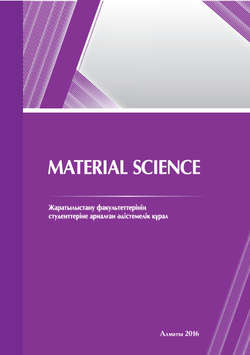Читать книгу Material science. Жаратылыстану факультеттерінің студенттеріне арналған әдістемелік құрал - Шолпан Гумарова - Страница 1
Different types of materials
ОглавлениеThe materials used in various branches of electrical engineering may arbitrarily be divided into two large groups. The first group comprises constructional materials which mainly go into the manufacture of auxiliary parts and components of electrical and radio devices. The second group includes materials used for the fabrication of wires, cables, waveguides, antennas, insulators, capacitors, resistors, inductors, transformers, electric motors and generators, magnets, diodes and transistors tubes, electromemory devices, and so forth.
The properties of these materials determine the performance of insulation systems and electrical devices designed, for example, to generate, transmit, rectify, and modulate electrical signals.
During operation of the devices, the materials are exposed to an electric or a magnetic field or both. According to their behavior in an electric or magnetic field, the materials are respectively classed as conducting, semiconducting, dielectric, magnetic, and nonmagnetic.
Conducting materials serves as carriers of electric current. They generally show a fairly low or preset resistivity. This class includes superconducting and cryoconducting materials, whose resistivity at very low temperature is rather small, and also high-resistivity materials used for resistors and electrical heating elements.
Semiconducting materials are employed where it is required to produce devices with a conductance controllable by voltage, temperature, illumination, and other factors. These materials are used for the manufacture of diodes, transistors, thermistors, photoresistors, and other semiconductor devices.
Dielectrics are mainly used as elecrtical insulating materials due to their resistivity. The purpose they served in this case is to impede the flow of electric current along the routes hazardous to the operation of a device. In capacitors, dielectric materials are used to provide for a specified capacitance.
Active dielectrics differ from common dielectrics (electrical insulating materials) in that they take an active part in the operation of an electric circuit; the components made from these materials serve to generate, amplify, modulate, and shape electric signals. Active dielectrics include materials applied in lasers and masers, as well as ferroelectrics, piezoelectrics, pyroelectrics, electrooptic and nonlinear- optic materials, electrets, and others.
Magnetic materials are capable to remain in this state after removal of the magnetic field. In contrast, nonmagnetic materials cannot be magnetized when placed in a magnetic field. Magnetic materials go into the manufacture of cores for inductors and transformers, magnetic memory devices, permanent magnets, and so on.
By their states of aggregation, electrical and radio engineering materials are classified into solids, liquids, and gases. In radio electronics, use is also made of the fourth state of matter, called plasma, which can originate, for instance, attendant upon dielectric breakdown.
Structurally, solid materials can be monocrystalline, polycrystalline, amorphous, and amorphous-crystalline.
Monocrystals are homogeneous anisotropic substances which display a regular arrangement of atoms throughout the entire volume and consists of periodically repeating identical crystal cells. By the kinds of crystal symmetry, all crystals can be divided into 32 classes that fall under 7 crystal systems. The electrical and magnetic properties of crystals that fall into different systems and classes vary substantially.
Polycrystalline materials consists of a large number of small crystal grains grown together and randomly oriented in various directions. These included metals and many ceramic materials. Polycrystalline substances are usually isotropic. But if the crystal grains are made oriented in a certain direction (for example, by mechanical treatment of a metal, or polarization of ferroelectric ceramics), a metal becomes anisotropic. Such substances with an artificially created anisotropy are called grain-oriented or texture materials.
Amorphous materials lack an ordered arrangement of atoms. These are solidified liquids, which are formed with lowering temperature due to a comparatively fast rise in viscosity that impedes the motion of molecules and thus prevents the formation and growth of crystals. Glasses and reins are examples of amorphous materials.
Amorphous-crystalline materials are partially crystallised amorphous substances. Such a structure is inherent in most polymers. When submitted to elevated temperature, glasses of certain compositions tend to crystallise; minute crystals that form in a molten glass during cooling render it opaque, and the glass transforms into an amorphous-crystalline material called a nucleated or devitrified glass.
Exercises:
I. Memorize the following words and word combinations:
II. Find the Kazakh (Russian) equivalents to the following word combinations:
А) Auxiliary parts; fabrication of wires; materials are exposed to a magnetic field; show preset resistivity; to impede the flow of electric current; a regular arrangement of atoms; randomly oriented crystal cells; ceramic materials.
В) керамические материалы; вспомогательные детали; правильный порядок в расположении атомов; на материалы воздействует магнитное поле; хаотически ориентированные в разных направлениях; кристаллические ячейки; обладают заданным удельным сопротивлением; изготовление проводов; препятствовать прохождению тока.
С) керамикалық материалдар; көмектескіш бөлшектер; атомдар орналасуындағы дұрыс реттілік; материалдарға магниттік өріс әсер етеді; әр түрлі бағыттарда хаосты бағдарланған; кристалл ұяшықтар; берілген меншікті кедергіге ие; сымдар дайындау; тоқ өтуіне кедергі жасау.
III. Translate into English using the active vocabulary of the lesson:
IV. Translate at sight
Advanced experimental methods, such as thin-foil electron microscope or neutron diffraction analysis, made it possible to study elements and defects of crystal structures and the laws of transformations in materials underthe influence of external factors (temperature, pressure, etc.).Analysis of the physical (density, electrical and thermal conductivity, magnetic modulus, etc), technological (fluidity, deformability, machinability, etc), and operating properties (corrosion and wear resistance, fatigue strength, heat and cold resistance, etc) are helpful in determining the most rational and efficient applications for various materials.
V. Retell the text.
